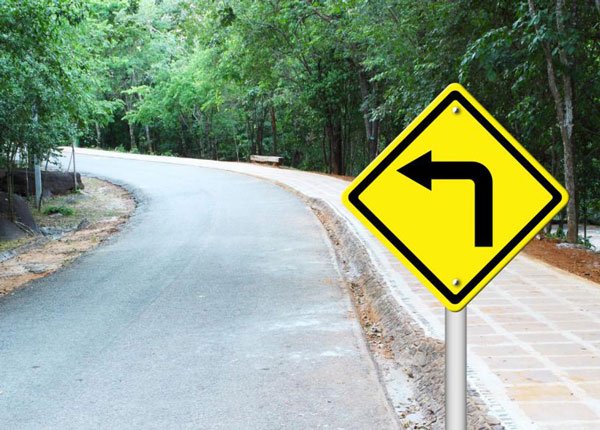

Turning left is riskier and demands more caution than turning right, because the turn will take you across the path of traffic which is traveling toward you, from the opposite direction. Of the roughly 2.5 million intersection collisions documented by the Federal Highway Administration (FHA) each year, most involve left turns.
Be sure to signal your intention to turn left as early as possible, while observing any right-of-way laws that are relevant to your situation. Drivers must also take particular care when turning left onto a street from an alley or driveway and learn how to use a center left-turn lane.
Follow these steps to make a left turn at an intersection:

A “No Left Turn” traffic sign prohibits left turns at an intersection. It is frequently posted at intersections with one-way streets, where turning left would place drivers in the position of going against traffic.
If traffic lights control the intersection, abide by signals.
Green arrow:
When a green, left-pointing arrow is present, you have the right-of-way and your left turn is protected. Any opposing traffic and pedestrians which may cross your path will be stopped by a red traffic light. Be sure to allow any vehicles and pedestrians who are already crossing the intersection time to pass before executing the left turn. When the arrow switches to yellow, the time in which you can make a protected left turn is about to end.
Solid green signal:
Drivers may turn left when a solid green signal is present but MUST yield to opposing traffic before doing so. This is even permitted at intersections where a green left-turn arrow is present but not active. Turning left under a solid green signal is known as an “unprotected left turn”. There may be a sign marked “LEFT TURN YIELD ON GREEN” to remind you of the turning protocol, though this is not guaranteed.
Solid red signal:
Turning under a solid red signal is prohibited. However, some states will permit drivers to turn left into a one-way street when a red signal is present. Check your state driver’s manual to find out whether this rule applies in your area. If the intersection is marked with a “NO TURN ON RED” or a “NO LEFT TURN ON RED” sign, you must not turn until the signal light has changed.
The correct procedure for making a left turn alters slightly is based on whether you are dealing with one-way or two-way streets..
You should start the maneuver from the lane furthest left, when turning left from a one-way street onto another one-way street. Complete the turn in the same lane. Turning left onto a one-way street is usually permitted when a solid red traffic signal is present – check your driver’s handbook for details. You may find that more than one lane is reserved for turning left at a one-way to one-way intersection. Signs and pavement markings will make this evident.
The same instructions as above apply when turning from a one-way street onto a two-way street. Though here, you should start in the far left lane and return to the lane nearest to the lane divider. Do not switch lanes on the intersection.
Begin the left turn in the furthest lane to the left, when turning left from a two-way street onto another two-way street. Remain in the same lane, taking care to yield to traffic and pedestrians if the left turn is unprotected. Turn without swinging your car wide as traffic traveling from the opposite direction may be turning left at the same time.
When it comes to turning left on a red traffic signal, there is no standalone rule that tells you whether it is permitted. It is often allowed, though only when certain conditions are met. These conditions may vary state-by-state, so it is essential to read up on this issue in your driving manual. Most states permit left turns under a solid red signal when:

Most states allow drivers to make left turns on red, unless a traffic sign prohibiting the maneuver is posted at the intersection. Drivers must stop and yield to all traffic and pedestrians before turning left on red signal.
Some intersections have a center left-turn lane which can be used by traffic moving in both directions. This is also known as a “two-way left-turn lane”. Center left-turn lanes allow drivers to turn left without holding up traffic that is traveling straight through the intersection.
Getting to grips with the rules concerning two-way left turn lanes is easy:
Find out with our free quiz!